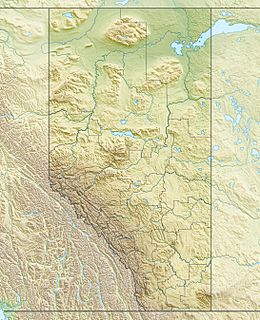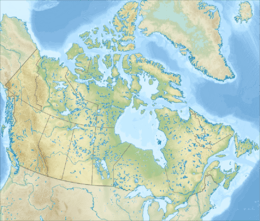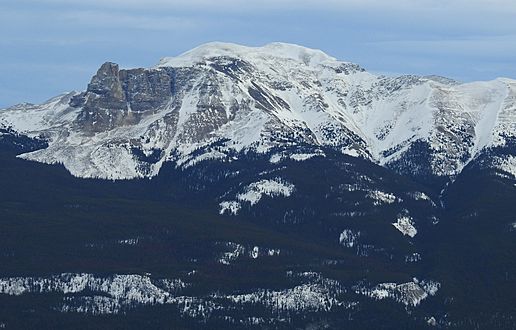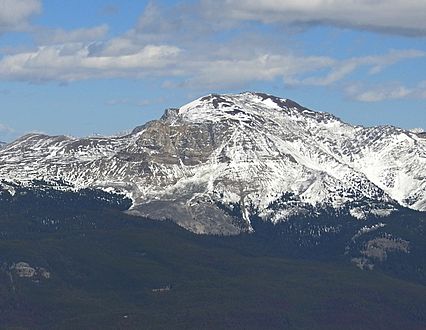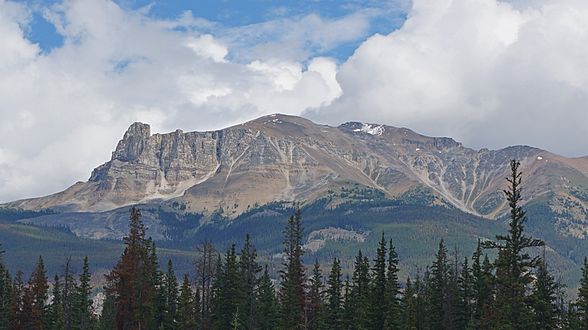Mount Tekarra facts for kids
Quick facts for kids Mount Tekarra |
|
|---|---|
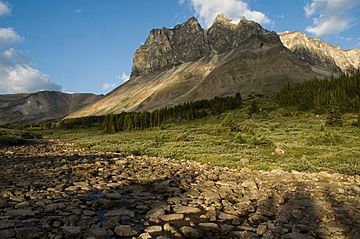
Mount Tekarra
|
|
| Highest point | |
| Elevation | 2,694 m (8,839 ft) |
| Prominence | 279 m (915 ft) |
| Parent peak | The Watchtower (2791 m) |
| Listing | Mountains of Alberta |
| Geography | |
| Location | Jasper National Park Alberta, Canada |
| Parent range | Maligne Range Canadian Rockies |
| Topo map | NTS 83C/13 |
| Geology | |
| Age of rock | Cambrian |
| Type of rock | Sedimentary rock |
| Climbing | |
| First ascent | 1915 by Morrison Bridgland |
| Easiest route | Scramble |
Mount Tekarra is a tall mountain, about 2,694 meters (8,839 feet) high. It's found in the Athabasca River valley, inside Jasper National Park in Alberta, Canada.
This mountain is at the northwest end of the Maligne Range. You can easily see it from the town of Jasper and from the Icefields Parkway, a famous scenic road. Its closest taller neighbor is The Watchtower, which is about 7 kilometers (4.3 miles) to the east.
Contents
Mountain History
How Mount Tekarra Got Its Name
Mount Tekarra got its name in 1859 from James Hector. He was an explorer who traveled through the Canadian Rockies. The mountain is named after Tekarra, an Iroquois guide and hunter. Tekarra helped James Hector explore the Athabasca River area during a big trip called the Palliser Expedition.
First Climbers
The first time someone officially climbed to the top of Mount Tekarra was in 1915. The climber was Morrison P. Bridgland. He was a Dominion Land Surveyor, which means he was a government surveyor who mapped out land. Bridgland named many mountains in Jasper National Park and the Canadian Rockies. The name "Mount Tekarra" was officially recognized in 1947 by the Canadian government.
Mountain Rocks and How They Formed
Mount Tekarra is made of sedimentary rock. This type of rock forms from layers of sand, mud, and tiny bits of plants and animals that settle over time. These layers get pressed together and harden into rock.
The rocks in Mount Tekarra were formed during the Cambrian period. This was a very long time ago, about 541 to 485 million years ago! Later, during an event called the Laramide orogeny, huge forces pushed these rocks up. This movement caused the rocks to fold and break, creating the mountains we see today.
Weather Around Mount Tekarra
Mount Tekarra has a subarctic climate. This means it has very long, cold, and snowy winters. The summers are usually mild. Temperatures can drop really low, sometimes below -20 °C (-4 °F). With the wind, it can feel even colder, below -30 °C (-22 °F).
The snow and rain that fall on Mount Tekarra melt and flow down the mountain. This water drains into the Maligne River and Tekarra Creek. Both of these creeks eventually flow into the larger Athabasca River.
Gallery
-
Mt. Tekarra from Marmot Basin Ski Resort
-
Mount Tekarra from The Whistlers
Images for kids
-
Mount Tekarra as seen from Roche Bonhomme summit


